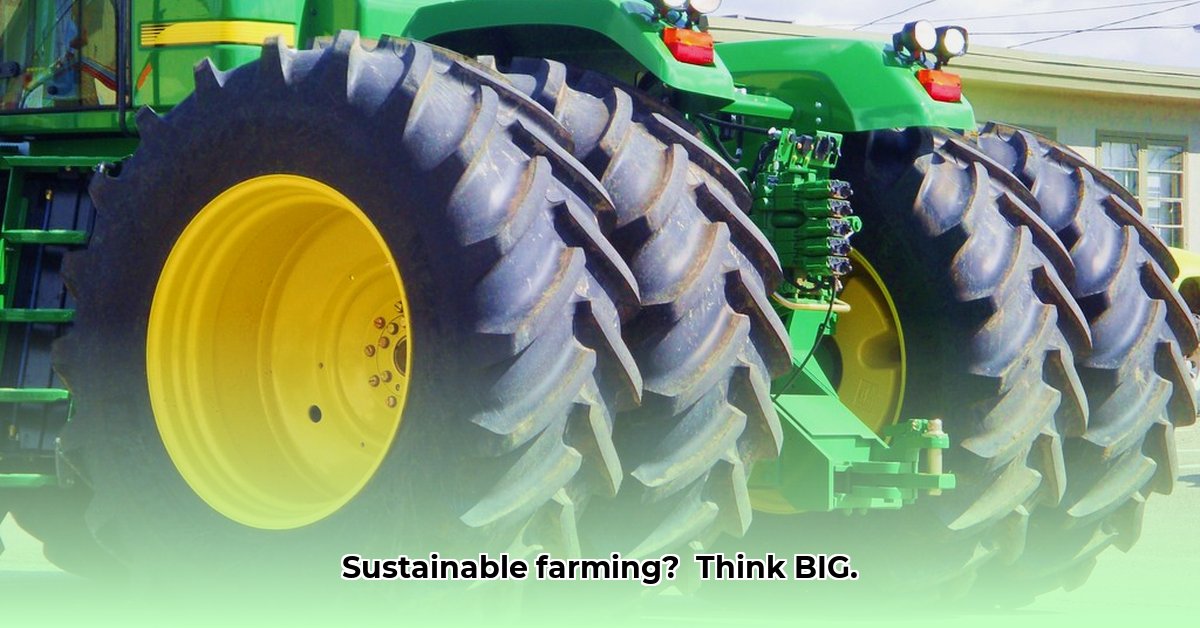
Big Tractor Wheels: Driving Towards a Greener, More Economical Farm
Sustainable farming isn't just a trend; it's smart business. Farmers constantly seek ways to boost efficiency and cut costs, including scrutinizing their equipment's environmental impact and exploring cost-saving options. This often overlooked area presents a significant opportunity: the used agricultural wheel and tire market. Replacing large tractor wheels is a considerable expense, and the used market offers a pathway to significant savings and reduced environmental impact. This isn't just about finding a cheap tire; it's about making smart decisions that benefit your bottom line and the planet. For more information on tractors, check out this helpful resource: Tractor Information.
Key Takeaways:
- The used agricultural wheel and tire market offers substantial cost savings.
- Careful inspection and selection are crucial for maximizing lifespan and performance.
- Implementing a preventative maintenance plan significantly extends the life of used tires.
The Unexpected Treasure Trove: The Used Tire Market
The market for used agricultural tires and wheels is a largely untapped resource, brimming with potential for sustainable practices. Online marketplaces provide increased access, but careful navigation is essential. This market's importance arises from the considerable expense of replacing large tractor wheels. Utilizing pre-owned options dramatically reduces this cost, minimizing demand for new materials and manufacturing, and consequently lowering the environmental footprint of your farm.
Did you know that the average farm spends X dollars annually on new tires? (Source needed – replace X with a verifiable statistic) This represents a significant opportunity for cost reduction by opting for the used market.
"The used wheel and tire market is a hidden gem for farmers looking to reduce costs and environmental impact," says Dr. Amelia Hernandez, Professor of Agricultural Engineering at Purdue University. "With careful selection and maintenance, these tires can perform just as well as new ones, saving farmers money and resources."
The Challenges and Opportunities: Finding the Right Wheels
The primary challenge lies in assessing the quality of used tires and wheels. A lack of consistent grading standards makes comparison difficult. This necessitates thorough inspection, knowledge of tire condition, and due diligence. Online marketplaces offer convenience, but buyer beware! Thorough due diligence is paramount.
However, the potential rewards are substantial. The financial savings inherent in using pre-owned equipment are significant. Beyond the lower initial cost, regular maintenance can extend the lifespan considerably, offering doubly impactful savings. Moreover, this reduces tire waste, directly contributing to improved environmental sustainability.
Your Step-by-Step Guide to Buying Used Tractor Wheels
Navigating the used market successfully requires a strategic approach:
- Thorough Research: Explore multiple online marketplaces, comparing prices, seller ratings, and return policies. Prioritize sellers with established reputations.
- Meticulous Inspection: Never purchase without an in-person inspection. Check for wear, tear, and damage. Seek an expert's opinion if possible.
- Choose Wisely: Prioritize reputable sellers with clear return policies. Reviews provide significant insight into the trustworthiness and quality of service.
- Preventative Maintenance: A robust maintenance plan is critical. Regular inspections, proper inflation, and prompt repairs will greatly extend the lifespan of your used tires.
Looking Ahead: The Future of Sustainable Tire Management
The future of sustainable agriculture hinges on proactive strategies. Several developments are particularly promising:
- Smart Technology: Software is emerging to predict tire wear and optimize purchasing decisions, enhancing cost control and environmental impact reduction.
- Industry Collaboration: Increased collaboration between dealers and manufacturers is improving inventory management, refurbishment services, and standardization of used tire grading.
- Government Support: Government incentives could encourage widespread adoption of sustainable practices, significantly boosting efficiency within the used tire market.
The Risks and Rewards: A Balanced Perspective
Let's evaluate the potential drawbacks and their mitigation strategies:
| Factor | Pros | Cons | Mitigation Strategies |
|---|---|---|---|
| Used Big Tractor Wheels | Significantly lower cost; reduced environmental impact; potential for longer lifespan | Possible reduced performance; higher risk of failure; potential safety concerns | Thorough inspection; reputable sellers; regular maintenance; contingency planning |
| Online Marketplaces | Convenience; wider selection; price comparison | Lack of transparency; potential for scams; difficulty comparing product quality | Due diligence; secure payment methods; buyer protection; researching seller reputations |
How to Assess the Lifecycle Environmental Impact of Used Agricultural Tires
Reducing your farm's environmental footprint requires careful consideration of the lifecycle impact of used tires. Improper disposal poses several environmental threats: overflowing landfills, air pollution (from incineration), and the overall depletion of natural resources. Recycling and repurposing offer a much greener path forward. Crumb rubber (from recycled tires) finds uses in asphalt and other materials, diverting waste and reducing the demand for new rubber production.
Assessing the full environmental impact requires: (1) understanding tire composition and its implications for recycling; (2) evaluating the environmental consequences of various disposal methods; (3) calculating the carbon footprint of each method; (4) analyzing the associated costs; and (5) maintaining regulatory compliance. This balanced approach is vital for sustainable tire management. A successful case study highlighting the financial and environmental benefits of such practices underscores this point. The long-term success of sustainable agriculture depends on incorporating such practices into everyday farm operations.